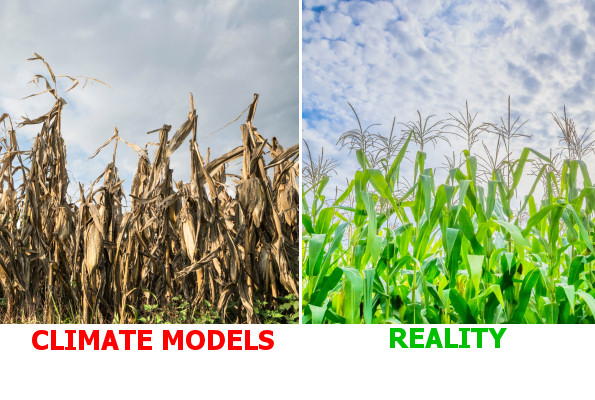A recent post at the news and opinion website PJ Media makes the point that the climate models used to promote green policies have overestimated the warming seen in the Corn Belt of the United States. This is true, and in fact the temperature data from the region shows a much lower rate of warming than any of the 36 commonly cited models.
The article, “Science v. Ideology: 36 Climate Models Overestimated Warming in U.S. Corn Belt,” references evidence compiled by climatologist Dr. Roy Spencer, reported on by Steve Milloy of JunkScience.com, that compared the 50-year area-averaged temperature trend from 1973-2022 to predictions from climate models over the same region and time period.
From Dr. Spencer’s blog post:
The climate models relied upon by the United Nations Intergovernmental Panel on Climate Change (IPCC) are known to overestimate warming compared to observations. Depending upon the region (global? U.S.?), temperature metric (surface? deep ocean? lower atmosphere?) and time period (last 150 years? last 50 years?) the average model over-estimate of warming can be either large or small.
But nowhere is it more dramatic than in the U.S. Corn Belt during the growing season (June, July, August).
The data indeed shows a very stark difference between observed temperatures and the model predictions that so many groups, including individual researchers, governments, and intergovernmental groups like the IPCC, use to make alarming claims about future warming. (See figure below)

The actual temperature observations data (in blue) does not agree with any other model forecast temperature data (in red). This clearly demonstrates that, at least in the U.S. Corn Belt, which as explained by Climate Realism here, for example, is often the target of false claims that climate change is threatening crop production, warming trends have been exaggerated in popular models, and in some by substantial margins.
The author of the PJ Media article, Catherine Salgado, writes that this outcome is “completely foreseeable after 50+ years of failed climate predictions,” and she is correct.
As I have listed in a previous post on the subject of failed predictions, the examples are numerous, and have been thoroughly debunked in other Climate Realism posts: Al Gore once said Kilimanjaro would be ice-free by 2016, here, or that there would be no more glaciers in Glacier National Park by 2012, here; climate scientists’ claims on ocean current acceleration, here; and numerous climate alarmist celebrities and public figures claimed that we have less and less time to stop using fossil fuels before catastrophes commence, here.
On the subject of models specifically, as Climate Realism also consistently covers, climate models have been proven to be largely unreliable, and often totally contrary to real world measurements. Even many climate scientists who are otherwise on board with climate alarm have begun to admit that emissions scenarios like Representative Concentration Pathway 8.5 (RCP8.5) and SSP5-8.5, for example, are highly implausible, and even The Conference of Parties 26 (COP) and 27 dropped them from regular reference.
Unfortunately, many of those models seen in Spencer’s chart, including the ones that incorporate the most extreme scenarios, are still referenced and used in other research investigating alleged impacts of climate change. If this poorly performing foundational data is what is being built upon, then the conclusions of the research that depend on it are equally suspect.
All those involved in breaking this story, including and especially Dr. Roy Spencer for his work on the actual data, Milloy for his presentation of it, and Salgado for reporting on the results, should be commended, because this very clear presentation of the disparity between model predictions and reality is not often covered in the media.

















” If this poorly performing foundational data is what is being built upon, then the conclusions of the research that depend on it are equally suspect.”
The outputs of models are not data. They might be foundational estimates, but are a poor foundation regardless.